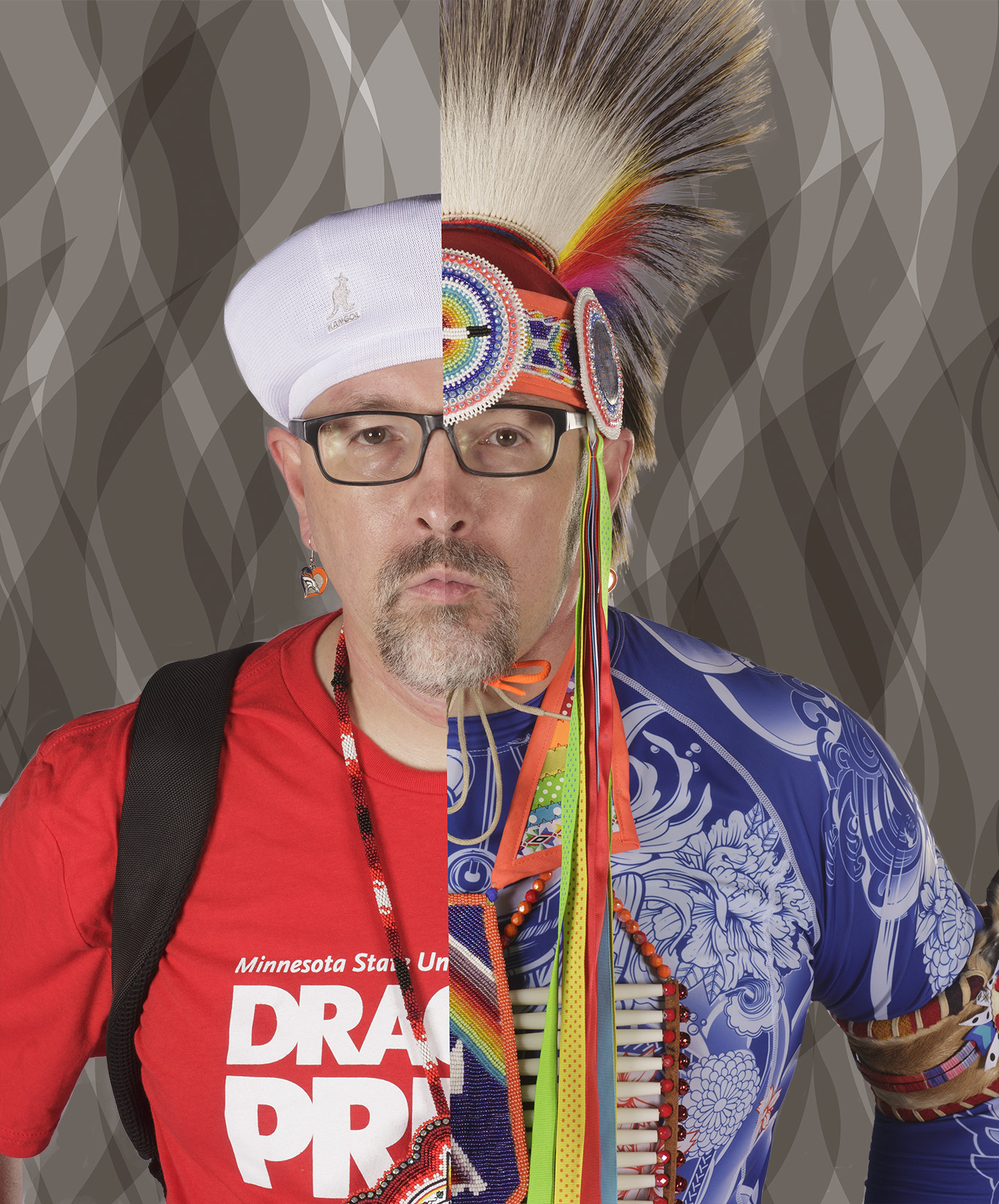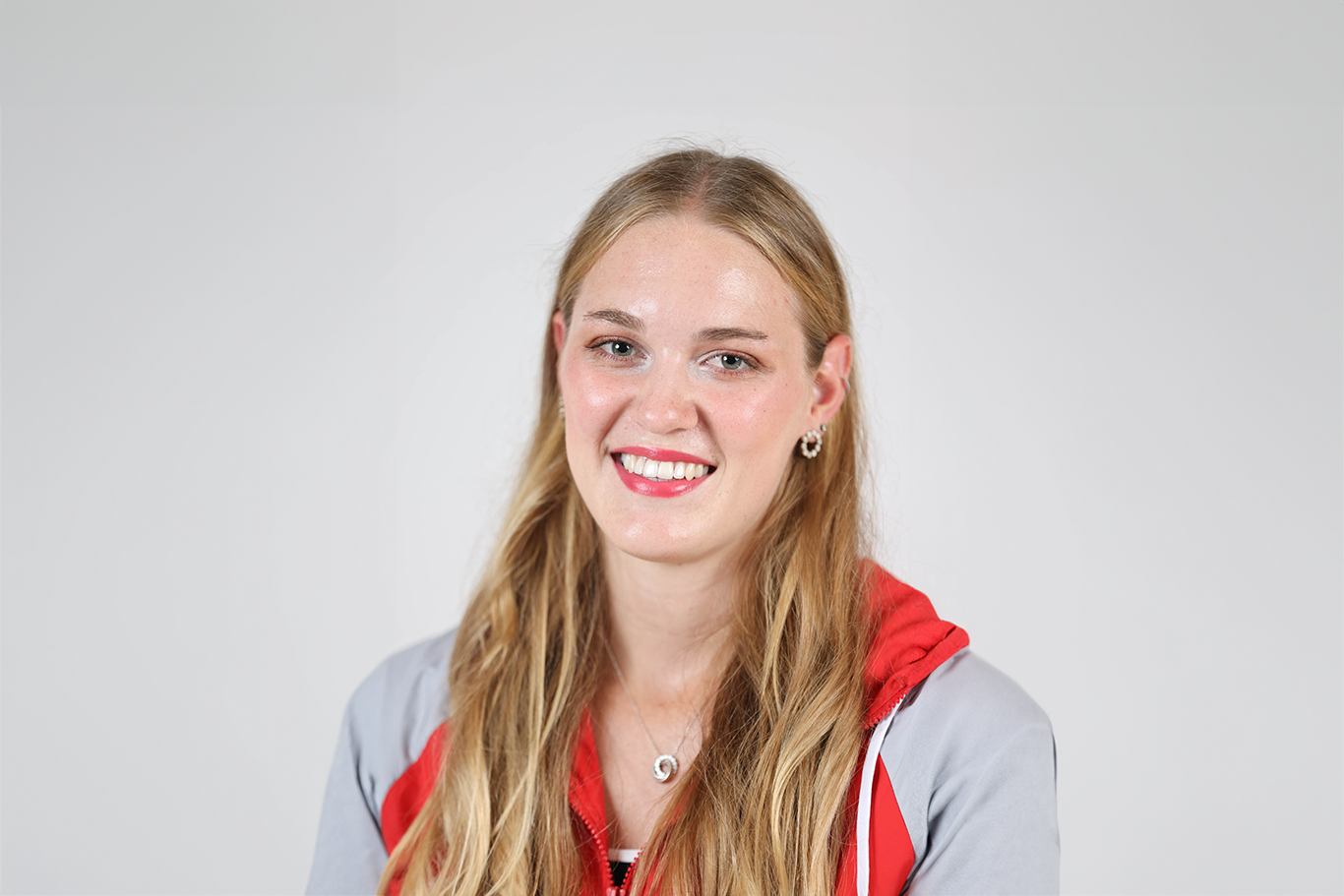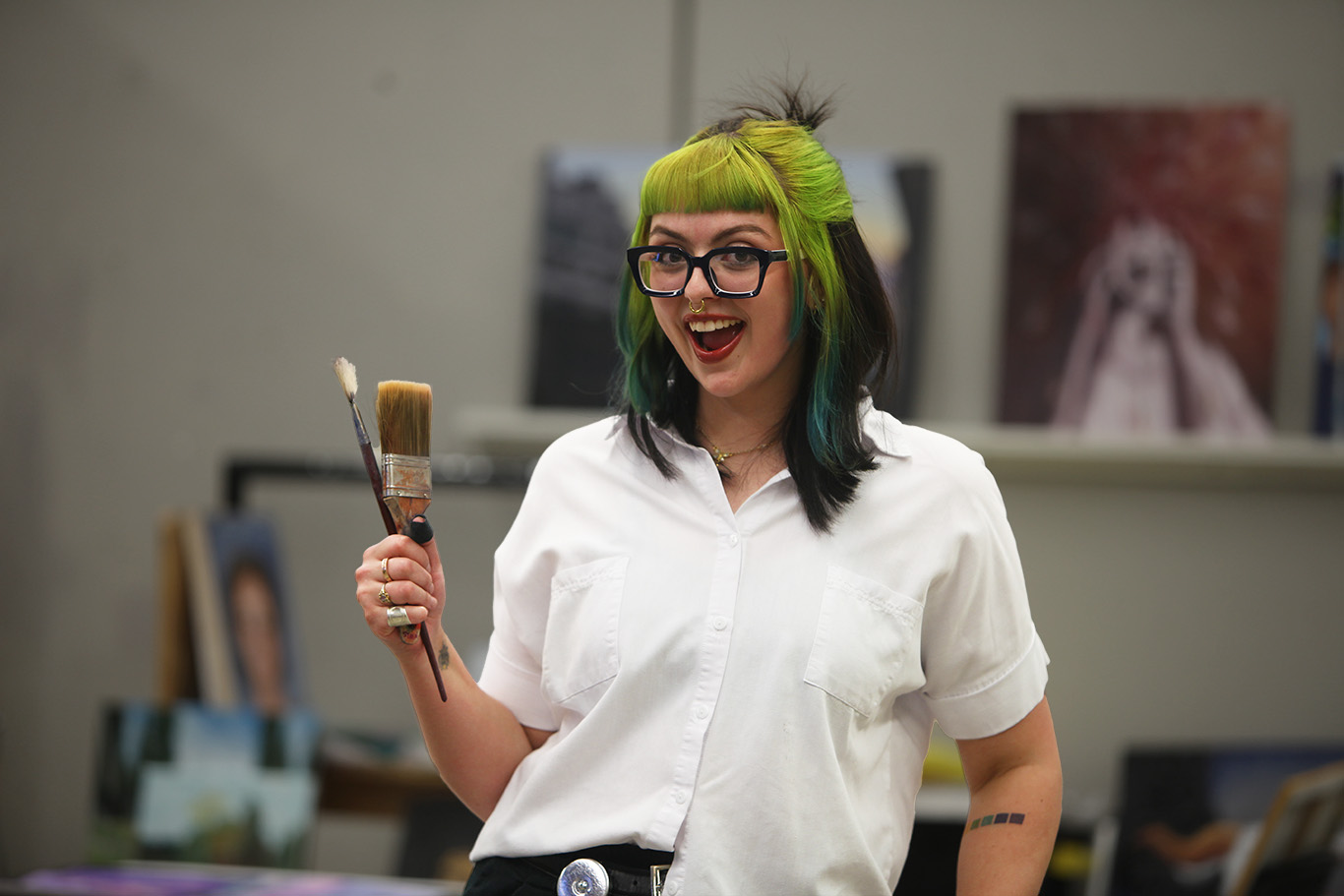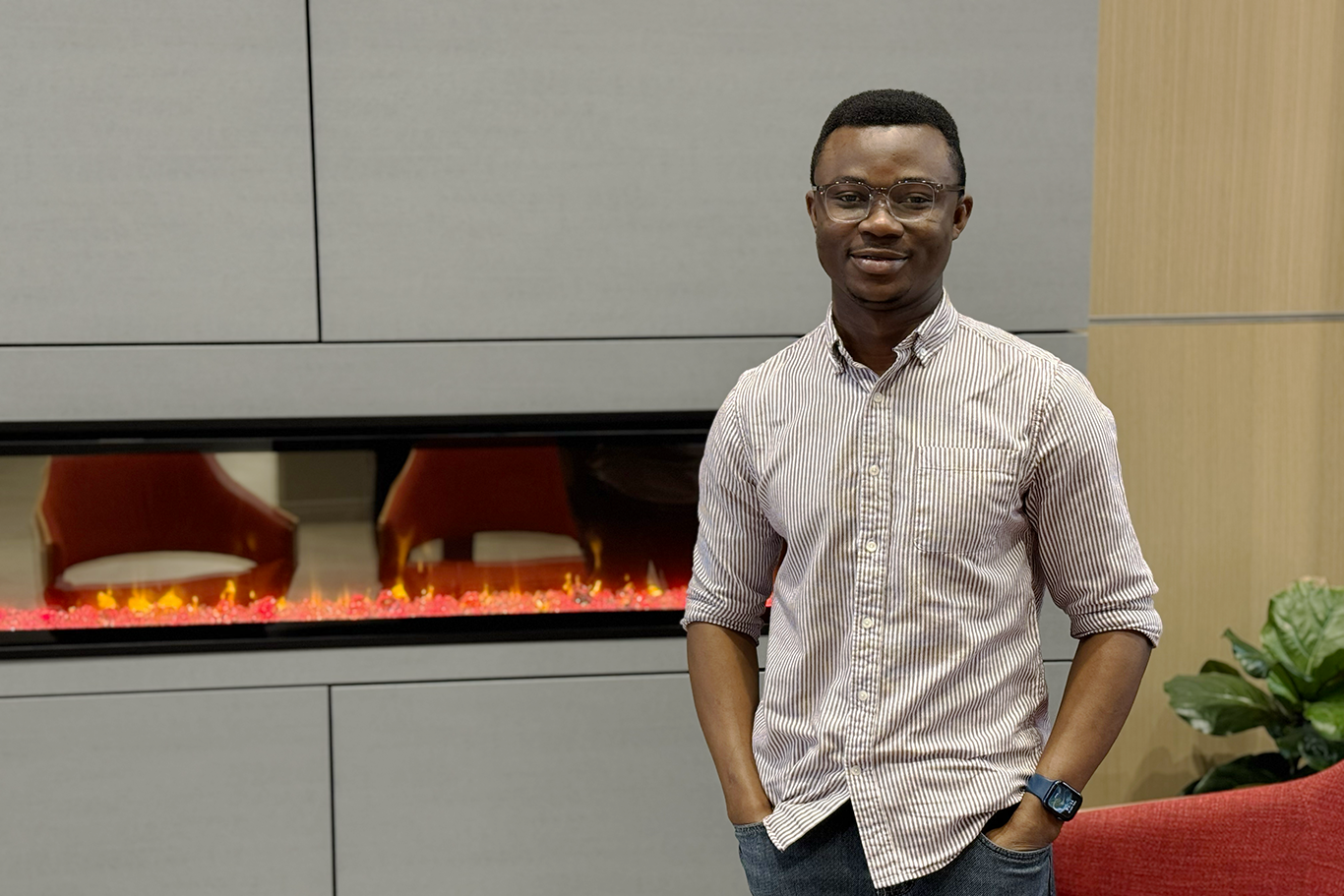MSUM student powwows his way back home
The dancer beat his moccasins in time with the rhythm, swaying and turning fluidly like tall prairie grasses in the winds of the northern plains, floating with the drumbeats and joyous singing voices back through time immemorial, forward to time yet unknown and returning again to the present circle of The People.
The deep drumbeat stopped, abruptly, the dancer with it. The Grand Entrance was done, but the powwow had just begun.
Dennis Williams, The Grass Dancer, was home again.
This particular homecoming came during 33rd Woodlands & High Plains Powwow at Concordia College in April 2022. Minnesota State University Moorhead, Concordia College and North Dakota State University take turns hosting the annual event.
Dennis, 48, a part-time MSUM student in art education, shared his gift with Fargo-Moorhead and surrounding communities as the powwow’s head male dancer.
But Dennis has called many places home over the course of his long journey.
His path has taken him from the White Earth Nation in central Minnesota to foster homes, adoptive Native families, high school art classrooms and track teams across Colorado, Minnesota and Wisconsin, and from the University of Minnesota-Duluth track team to powwows throughout the Upper Great Plains. Ultimately, he found his way back to where he started, in central Minnesota with his Ojibwe family and culture.
Dennis says the Ojibwe culture kept him anchored across the miles, the trials and the victories, too, just as running helped maintain his focus on always doing his best and moving forward.
And powwow dancing? That’s where he feels truly at home.
A Struggle Out of the Blocks
Dennis’ mother, Sandy Yasgar Williams, was one of hundreds of Native children taken forcefully from their families in the United states in the late 1800s and early to mid-1900s. She was sent to what’s been described to him as an orphanage, “but they were using it to adopt the children out to non-Native families,” he said. She had her first child when she was 16, Williams’ older brother, and he was born a couple of years later in Lacrosse, Wis.
It was a difficult time, moving frequently from place to place and living with his mother’s substance abuse and occasional incarceration, but Dennis remembers her being a deeply caring person who did the best she could, given the trauma she’d experienced. He and his siblings were in and out of foster care for many years in Duluth, Minn., and several communities in Wisconsin and Colorado.
Despite never staying in one place for long, the boy excelled at art, and he was flat-out fast. In high school, Dennis ran cross country and the 300-meter hurdles, the 400 meters and the 4x100-meter relay in track.
“It kept me working hard to get the grades I needed to compete,” Dennis said, crediting athletics with keeping him grounded through the ups and downs. “I've always been focused and had goals in mind.”
Prior to his senior year in Golden, Colo., he’d been hanging out at the home of his friend, track teammate and fellow Native, Kipp Stiffarm. It started with weekends, but before long he was there almost every day. The Stiffarms were a powwow family, and they started taking Dennis along.
Soon he was joining in the dance, wearing powwow regalia his adoptive mother, Jonney Bear Cub Stiffarm, helped him create.
“One night we were in the car going to the powwow at the Indian Center in Denver, and Kip’s like, ‘I think my parents are going to adopt you into our family.’ So I asked how that would happen. Kipp said, ‘During the powwow, they'll give you a gift and then announce it and everybody will know what family you belong to.’ And sure enough, Jonney and Tater Stiffarm adopted me into their family, which is a big deal in our culture.”
It wasn’t an “official” adoption, in terms of being recognized by the state, but an expression of love and caring that’s common among Native families and tribes.
He kept running, too. In 1992, his senior year, Dennis broke his school’s 400-meter record, was named its athlete of the year and earned all-state honors. Several colleges came calling, including the University of Minnesota-Duluth. Dennis was leaning that way, not just for the chance to run for legendary track coach John Fulkrod, but also because the university had a strong Indian Studies program.
Following a year at Northeastern Junior College, Sterling, Colo., Dennis made it back to Duluth via UMD, where he began studying graphic design and joined the Anishinaabe (Ojibwe) Club. In the Ojibwe language, Anishinaabe means “the original people.”
“After being brought up in non-Native families, it was a chance for me to kind of get back in touch with my Indian side,” Dennis said. “It was founded in the early ’70s, during that time when AIM (the American Indian Movement) and everything was happening, and the Anishinaabe Club was a place where we could be together and feel comfortable. The college atmosphere was very different for most Native students, and it was a lot harder if you didn't have a place to support one another.”
He didn’t know how important that support was until he learned that his grandmother, Delores Gamache, had died. She had been a loving surrogate mother, providing his moral base and supporting him no matter what. Dennis struggled, mourning her loss, thinking about the past, being on his own for the first time and worrying about the future. His classwork suffered and he left UMD.
But he kept going back to the powwow circle.
The Wheel of Life
The circle is a powerful symbol for many Native Americans, including the Ojibwe. It represents the four directions, the four types of humanity – yellow, red, black and white – the four human needs – physical, mental, emotional and spiritual. It also forms the medicine wheel, which is important to many tribes.
“All of life’s cycle is beautiful – the sadness and the joy, life and death; and that they are all one,” Ojibwe Elder Lillian Pitawanakwat said. “There is life in death, death in life – that beauty itself resides within the balance of the whole circle.”

It’s one of the reasons powwows are organized in a series of circles, according to Murton McCluskey, a member of the Blackfeet Nation and longtime educator in Montana.
“The dancers are in the center of a circle, the drums and the audience form a circle around them, and the concessions and encampment form another circle around the gathering,” McCluskey wrote in an educational pamphlet about powwows. “This is symbolic of the life cycle. The powwow brings the circle of people closer to their family, friends and Native American culture.”
There is also deep meaning in the dancers’ regalia, with beads forming symbols of planetary bodies, natural scenes and animals. The rainbow, for example, represents the thunderbird, which “symbolizes power, nobility and strength, traveling from one horizon to the other. ss
“The things we wear, almost everything has been living at one time,” Dennis explained. “There’s the leather, and my roach (headdress) has deer tail hair, porcupine guard hair and two eagle feathers. So that's all been alive, just like us, and when we dance they move like they’re alive again. The spirit of those animals is with you, so you have to take care of them, feast them, give them water and do ceremonies with them. If you do, they’ll help you. It's good medicine.”
“There are no spectators at a powwow. Everyone is considered a participant, even if you don’t do anything but lend your presence. Everyone has a place in the circle of people.” – Murton McCluskey
Similarly, the various dances – such as the traditional, grass, fancy shawl and jingle styles – honor the past, present and future, as well as the living things that have passed or are passing through them.
For example, Dennis’ aunt Gladys “Sy” Wadena, once requested an individual dance at every powwow she attended. “She was my elder, and she always said, ‘I want my one dance,’” he explained. “You don't question that, especially with that kind of relationship. Also, you’re dancing for all The People, including the ones that are not able to dance for themselves anymore.”
Over the years and through hundreds of powwows, Dennis has gone from a novice wearing a black Fruit-of-the-Loom T-shirt adorned with yarn and store-bought moccasins to a respected dancer who weaves his own brightly colored, intricate beadwork into his regalia. For a while, even though there were many grass dancers on the local powwow circuit, people referred to Dennis as The Grass Dancer.
“I dance just for the love of it. Being able to go to a powwow and know that you're going to be involved in it, even be a major part of it, I love that,” Dennis said. “It’s also the singing and the drums, which represent the heartbeat of The People. The other part of it is people coming in, dancing and completing that circle.”
His abilities and dedication brought invitations to be the head male dancer at several powwows. It’s a tremendous honor and acknowledgement of a person’s character and contributions to the community.
“The Head Male Dancer and Head Female Dancer are... role models,” McCluskey wrote. “Individuals who exhibit outstanding traditional qualities are asked to serve in this capacity. The responsibilities of this position include being present throughout the powwow activities and leading the dancers by being the first to begin each dance.”
The planners for the 2022 Woodlands and High Plains Powwow were delighted to have Dennis on the committee and that he agreed to be the head male dancer.
“They knew about him and they knew his talent,” said Concordia College Pastor Dave Adams, who with his wife, Rev. Kim Adams, co-chaired the planning committee of college representatives and Indigenous people. “His passion for building community and belonging really shines through, both in the patient, inviting way he shared his knowledge with us and in how he went about being one of the lead dancers at the event. It was evident that, for Dennis, it was about the spirit of community and the spirit of those that were gathered there.”
Coming Full Circle
Dennis also gained more than a name for himself on the circuit. In 2000, at a powwow in Grand Portage, Minn., he met his wife, Dana Goodwin Williams, who also is an Ojibwe from the White Earth Nation. It was love at first sight, he said. They married and were living in Duluth, and in 2003 twins DeAndra and Genevieve were born. Raising a first child can be hard enough, but two at once? Their families recognized the challenge.
“Her grandmother, Honey, told her, ‘You need to come back home. It'll be easier for you guys here with family around to help,” Dennis recalls with a laugh. “So her aunties and uncles came with the U-Haul, loaded our house up and brought us back home. I was like, well, I guess I'm going back to White Earth.”
Goodwin Williams returned to school at MSUM, earned her bachelor of Fine Arts in elementary education and has risen to become the director for White Earth educational programs.

Dennis, meanwhile, was working with youth at facilities like the Mahnomen School District, the Circle of Life Academy in White Earth and the Boys & Girls Clubs of the White Earth Nation.
With their eight younger kids in school every day, Dennis saw an opportunity to go back to school himself. MSUM’s art education program and the quality of the faculty looked like a great fit. He started attending classes three days a week in 2019. It’s a lot of work, he said, but he’s enjoying it.
“In a way, it's kind of like dancing. It's the same kind of challenge only on a mental level,” he said. “Now I’m competing against myself to see how high a grade I can get. Every class is another new challenge, and that’s OK with me.”
MSUM Professor of Art Brad Bachmeier is Dennis’ academic advisor. “Dennis is an inspiring guy,” he said. “He’s definitely a hard worker and great role model with a heart for making a path to higher education for his family and bringing that knowledge back to his reservation to make a difference.”
The path will pass through three more semesters to finish his degree requirements, Dennis figures. His goal is to set up a fine arts program for junior and senior high school kids on the White Earth Reservation, teach the next generation of teachers and create a foundation for fine arts that will reach well into the future.
His competitive running years have long since passed, but Dennis keeps dancing. It gets a little tougher with each year – the knees and back aren’t as cooperative as they once were – but he’ll always be part of the powwow circle.
He takes comfort, too, from knowing that when he gets closer to closing his own earthly circle, another grass dancer will step in for him and others who can no longer sway like the prairie grasses, turn fluidly like the fish in the stream or tap their moccasins in the dance circle for themselves.
“Powwow...” Dennis said, trying to convey its significance not just for himself but also for his community and culture. “It’s a way of life.”
Make Sure Your Story Is Heard
Let us know how your life has been changed by being a Dragon: tell us your MSU Moorhead story today!
Send Us Your Story


